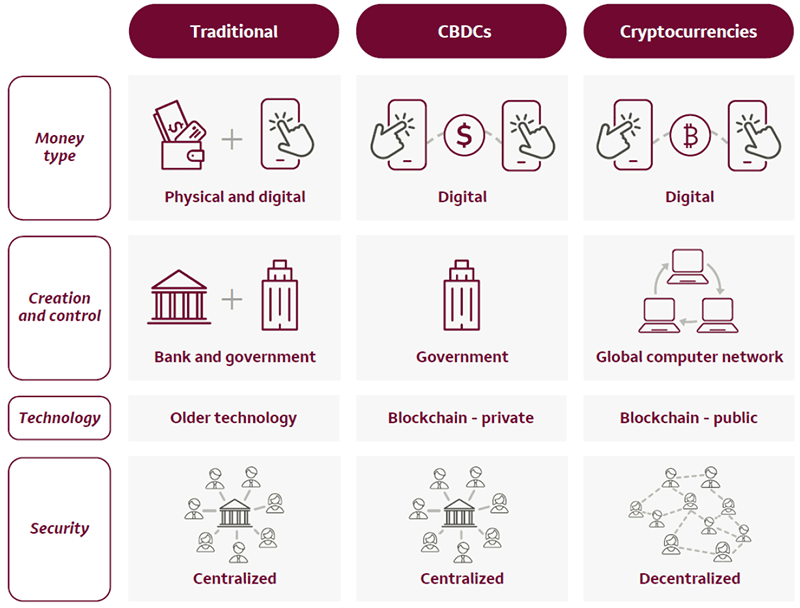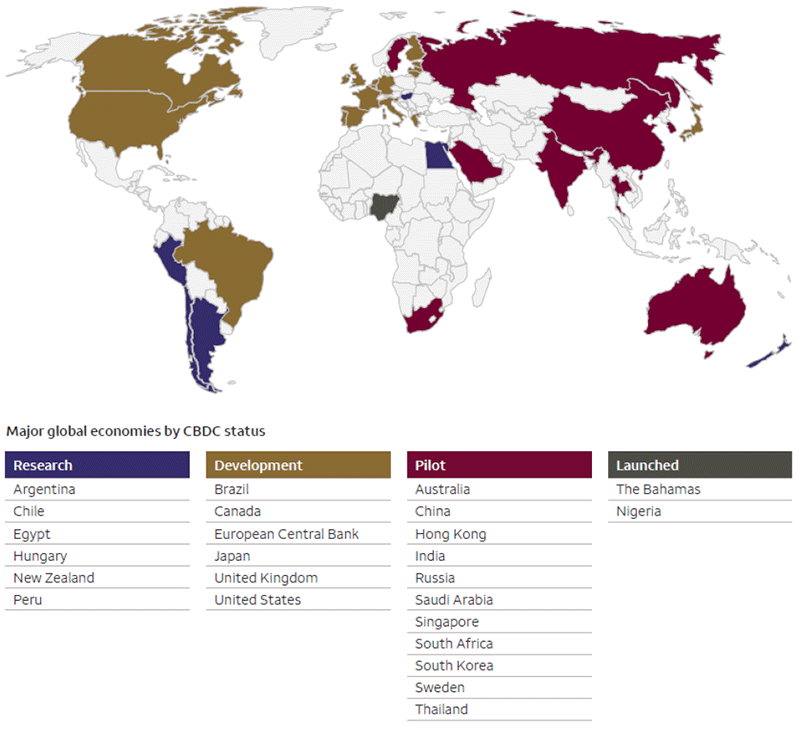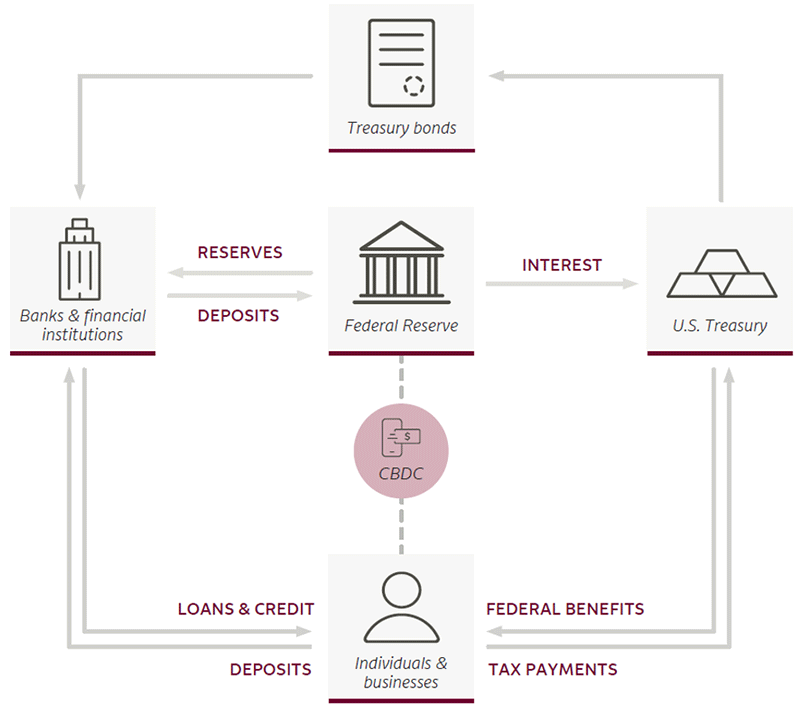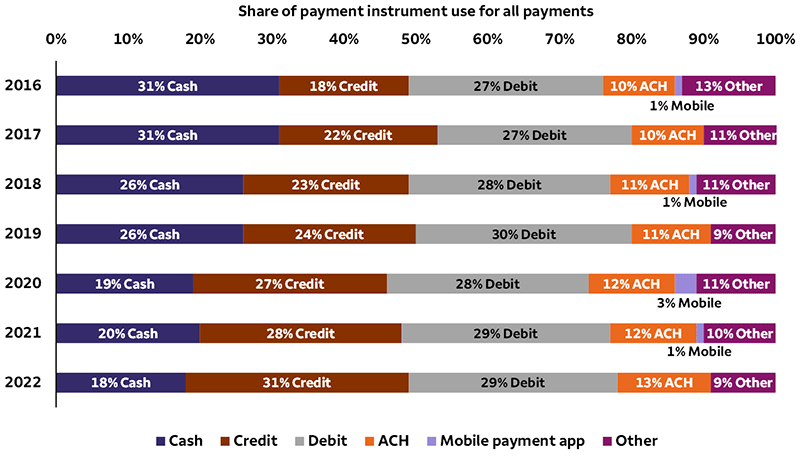October 19, 2023
John LaForge, Head of Real Asset Strategy
Mason Mendez, Investment Strategy Analyst
Central bank digital currencies and the future of money
Key takeaways
- Central bank digital currencies (CBDCs) are essentially a country’s fiat currency, rebuilt using blockchain-related technologies — in other words, a government’s own cryptocurrency.
- Many countries are studying the potential benefits of CBDCs, including the U.S., while a handful of countries, including China, have already started using CBDCs.
What it may mean for investors
- CBDCs bring the promise of faster, cheaper, and more secure global payments. They also bring concerns over personal privacy. Overall, a strong case in favor of creating a U.S. CBDC has yet to be made.
- A U.S. CBDC, should it be designed, would not replace the U.S. dollar. It would simply be a different version of the U.S. dollar.
What are CBDCs?
CBDCs are a new form of existing government currencies. They’re like cash, but digital only. One way to view them is as a digital upgrade to today’s analog money. CBDCs are essentially a country’s currency, rebuilt using blockchain-related technologies — the same used to create private cryptocurrencies, such as bitcoin. A CBDC is simply a government’s own version of a cryptocurrency.
What’s a cryptocurrency?
Cryptocurrencies originated in 2009 as a new type of money that could be securely moved over the internet. They are not physically minted or printed, like a dime or a $20 bill. Cryptocurrencies are digital, which means that they only exist electronically. Using them as a currency requires a digital device, such as a smartphone or a computer. The technology can move other types of value over the internet too — digital assets such as a house deed, real estate contract, or one’s digital identity. Cryptocurrencies are one of many new, digital assets being created with blockchain technologies.1
What are the technologies behind digital assets?
Digital assets are not created by one technology. A group of technologies combine to form a platform for constructing cryptocurrencies and other digital assets. Cryptography and blockchains are two of the most recognizable technologies on the platform. Cryptography is the study of secret codes, and blockchains are digital ledgers that keep track of digital asset movements and owner balances.
Why the name CBDC?
Figure 1 illustrates the main differences between traditional government-created monies versus private cryptocurrencies. Central banks are the government authorities tasked with overseeing today’s traditional money systems (left side of Figure 1). The CBDC name originated to distinguish between private cryptocurrencies, such as bitcoin, and versions created by national governments. Because governments are centralized entities, CBDCs are often referred to as “centralized.” And private cryptocurrencies are frequently referred to as “decentralized,” as they are operated by global communities (computer networks).
 Source: Wells Fargo Investment Institute, September 2023.
Source: Wells Fargo Investment Institute, September 2023.Is the U.S. the only country looking into CBDCs?
No. It is one of many. An August 2023 Atlantic Council study2, highlighted in Figure 2, estimated that many countries are studying CBDCs, but only 11 countries use CBDCs. China is the largest country using a CBDC, the digital yuan, with more than 25 million users and growing. Brazil is expected to release its own CBDC in 2024.
 Sources: Atlantic Council and Wells Fargo Investment Institute. Data as of August 28, 2023.
Sources: Atlantic Council and Wells Fargo Investment Institute. Data as of August 28, 2023.Does the U.S. have a CBDC?
No, but it is studying its potential. In April 2022, President Joseph Biden signed executive order #14067, which authorized the Federal Reserve (Fed) to begin a formal process of assessing the risks and opportunities of a U.S. CBDC. Should the Fed ultimately craft a design, it would still need to be authorized by law. On this topic, in March 2023, Fed Chair Jerome Powell stated that the issuance of a CBDC is “something we would certainly need Congressional approval for.” To be clear, no formal design has been released, nor has a release date been announced.
How long may it take before the U.S. creates a CBDC?
We suspect it will be some years before a U.S. CBDC is designed, approved, and used. Our best guess would be three to five years. The release of FedNow, a new fast payments program (not a blockchain-related technology) launched in July 2023, might give us some clues on the timeline, though. The Fed formally started studying the potential of FedNow in September 2013 — nearly 10 years before its release. While we are not expecting a CBDC release to take 10 years, we do believe it could be a few more years before a final design is reached.
Would a U.S. CBDC replace the U.S. dollar?
No, we don’t believe a U.S. CBDC would replace the U.S. dollar. A U.S. CBDC would be, simply, another form of the U.S. dollar. Dollars come in many forms already — physical cash, digital cash (such as digital wallet payment apps), and credit (credit cards, loans, etc.). When paying for lunch, as an example, one could pay with any of these. They are all payments in U.S. dollars. A CBDC will simply be another option, a different digital option, to pay for lunch in U.S. dollars. Figure 3 is a simplified view of U.S. money creation today, and what it may look like with a CBDC.
What kind of money is most private?
It is important to remember that all forms of money come with trade-offs. Physical cash is generally the most private way to transact, but even cash is not completely private. As an example, U.S. banks are required by law to report to the U.S. government all deposits and withdrawals of $10,000 or more, whether they be in cash, coins, wire, check, etc. What's more, cash is also the easiest to lose, damage, or have stolen. Reversing transactions is hard to do with cash, but an advantage of credit cards.
As for a CBDC, it appears at first blush that it could be one of the easiest forms of money to use, but also potentially the least private. Privacy has evolved as a main concern with a CBDC because it will be created by and be a direct liability of the Fed. This means that a CBDC has the potential to be distributed directly by the Fed to individuals and businesses, which is quite different from how money is created and distributed today.
Today, the Fed does not issue money directly to individuals, but oversees third parties, such as commercial banks, which create money in the forms of loans (credit) and deposits for individuals. This interaction can be seen on the left side of Figure 3. For added perspective on what the future may look like, we added a circle to Figure 3, which represents where a CBDC might fit into the U.S. money creation framework.
Notice that a CBDC has the potential to be distributed directly to individuals, which could make government payments, such as stimulus checks, easier for consumers. On the flip side, however, consumers may have concerns over direct dealings with the government over personal finances. Not only could these dealings become cumbersome, but they could come at the expense of individual privacy, too.
 Source: Wells Fargo Investment Institute, September 2023.
Source: Wells Fargo Investment Institute, September 2023.How would a U.S. CBDC be different than other digital platforms, such as Apple Pay or Venmo?
This depends on the CBDC’s final design, but most likely, consumers will interact with a CBDC the same as other digital financial platforms, such as Apple Pay or Venmo. For instance, paying with a CBDC will likely be as easy as tapping one’s smart phone at a retail kiosk. And one’s CBDC balance will likely be found near one’s cash balance on a personal banking statement or banking app.
Will a U.S. CBDC be backed by gold?
We doubt it. U.S. dollars have not been backed by gold since 1971. We believe a U.S. CBDC likely would be backed by the full faith and credit of the U.S. government, the same as all U.S. dollars today.
“I’ve heard that the U.S. already has a CBDC that went live in July 2023. Is this true?”
No, this is not true. What went live in July 2023 was a new fast payments system from the Fed, called FedNow (referenced earlier). Think of FedNow as financial payment rails, and U.S. dollars move over them. FedNow is an interesting new service used by banks in an effort to speed up payments to other banks, but to be very clear — it was not built using blockchain-related technologies. Even so, FedNow has been proven useful to consumers because payments, such as personal checks and payrolls, clear instantly versus the hours and days that have historically been the experience. A U.S. CBDC, should it come to pass, may move over the FedNow rails, or new rails may be designed using blockchain-related technologies.
If transactions are speeding up with FedNow, why the need for a CBDC?
FedNow is an upgrade to U.S. payment rails, and a CBDC, it is argued, could be an upgrade to the money that travels over those rails. One way to think of this is like the U.S. financial system receiving a technology upgrade. Some of the U.S. payment rails (bank to bank) were recently upgraded to version 2.0 with FedNow, but the money that moves over those rails, the U.S. dollar, is still running on version 1.0. And then there is the potential for version 3.0, which would be a rebuild of both the rails and the money with blockchain-related technologies.
Upgrading to version 3.0 is what many countries are examining most closely currently. Global travel is one example of how an American could benefit from a global upgrade to version 3.0. A U.S. dollar CBDC that could be safely transmitted over other global digital networks and easily exchangeable into other digital currencies could make global travel possibly cheaper and less cumbersome for Americans.
What are the main positives of CBDCs?
CBDCs bring the promise of faster, cheaper, more secure, and global payments. Imagine the cost advantages of not having to wait three to five business days for checks to clear, reduced exchange fees on global travel, and the ease of sending remittances to loved ones globally — instantly and cheaply. Some countries should benefit greatly from this technology upgrade, in our view, such as those where remittances account for substantial portions of gross domestic product (GDP).
What are the main negatives of CBDCs?
CBDCs are programmable, which means that they have the potential to be tracked, monitored, and shut down by authorities. “Potential” is the operative word, as the technology is flexible and can be designed to be privacy-friendly, too. While clearly no formal CBDC design has been set, many elected officials have begun to voice their concerns over personal privacy. This is the case with many Presidential candidates, too, so expect to hear the term CBDC regularly with the 2024 election approaching.
Will physical cash go away?
We doubt it. Physical cash plays a pivotal economic role in many parts of the world, and in the U.S. too. Cash is easy, reliable, and generally private, so we empathize when investors voice this concern, and the Fed does too. The Fed is on the record as saying that a CBDC is not meant to reduce or replace cash, but to offer U.S. dollar users another safe payment option. It is interesting to see in Chart 1 the steady drop in U.S. cash transactions as a percentage of total transactions, though. Cash transactions at the end of 2022 represented only 18% of total transactions, down from 31% in 2016 (dark purple bars in Chart 1). Another interesting point is that the COVID-19 lockdowns in 2020 and 2021 did not start the drop in cash transactions, but simply accelerated an ongoing trend.
 Sources: Federal Reserve of San Francisco, Diary of Consumer Payment Choice, and Wells Fargo Investment Institute. Data as of May 5, 2023. The "Other" category includes payments made with prepaid checks, prepaid mobile payment apps, and prepaid money orders.
Sources: Federal Reserve of San Francisco, Diary of Consumer Payment Choice, and Wells Fargo Investment Institute. Data as of May 5, 2023. The "Other" category includes payments made with prepaid checks, prepaid mobile payment apps, and prepaid money orders.Will I have an account with the Fed to hold my CBDCs, or is this something that a bank will do?
With no design in hand – not even a rough sketch – this is a tough call. What we do know is that it is currently illegal for an individual to hold an account with the Fed. Banks exist, at least in part, to fill this service. Figure 3 earlier in the report shows that money creation starts with the Fed, flows to the banks, and then ultimately flows to individuals. While it is possible that the Fed designs a CBDC aimed at having more direct contact with individuals, we believe that the Fed is not likely to push for this feature right away. The reason is that it adds an extra layer of complexity (the Fed dealing directly with consumers) to an already complex situation. In the end, with so many design options, it is probably best to wait on a final design before passing any judgments.
“I heard that there will be two kinds of CBDCs — one for banks and one for individuals. Is this true?”
Possibly. The reason two CBDCs might be an option is that the daily money needs of banks and financial institutions are quite different than the needs of individuals. Because of this, some countries are studying two CBDCs —one for financial institutions (wholesale) and a second for individuals (retail).
Should we be concerned about individual privacy with a CBDC?
This is one of the top questions we receive. Without a formal design to discuss, we do not know for sure. It is worth noting, though, that CBDCs are programmable money, and the FedNow financial rails are programmable, too. Individual privacy is something that should be carefully considered in the design of any CBDC, and the Fed has said so, too.
What will it be like to use a CBDC?
Being digital only, it will require the use of an electronic device, such as a smartphone, tablet, or computer. And it will probably feel like today’s digital experiences with bank websites and phone apps. It seems logical that a CBDC would fall into the “Cash” category on a bank statement, and it would probably be its own line item.
Do Americans need a CBDC?
In our view, a strong case has yet to be made that Americans "need" a CBDC. Central authorities, such as the Fed and Treasury, could certainly benefit from traceable money. CBDCs could give them valuable insights into not only the American economy, but the global economy, too, with the U.S. dollar as the world's reserve currency. Better monetary intelligence for central planners, however, must be weighed against the potential loss of individual privacies in a country founded on individual rights.
Bottom line
CBDCs are a new kind of money being studied by governments. It’s like cash, but digital only. Some see it as a digital upgrade to today’s analog money. CBDCs are essentially a government’s own cryptocurrency. The U.S. is one of the many countries in the early stages of studying them. In our view, a strong case to create a U.S. CBDC has yet to be made.
Should the U.S. design a CBDC, we believe it seems likely to us that it remains years away from launch. A U.S. CBDC, should it be designed, would not replace the U.S. dollar, according to the Fed; it would simply be a different version of the U.S. dollar. This new version of a U.S. dollar would have the same full faith and credit backing of the U.S. government, but it would be purely digital and could be issued directly by the Fed.
Risk Considerations
Forecasts are not guaranteed and based on certain assumptions and on views of market and economic conditions which are subject to change.
Virtual or cryptocurrency is not a physical currency, nor is it legal tender. Bitcoin and other cryptocurrencies are a very speculative investment and involves a high degree of risk. Investors must have the financial ability, sophistication/experience and willingness to bear the risks of an investment, and a potential total loss of their investment. An investor could lose all or a substantial portion of his/her investment. Cryptocurrency has limited operating history or performance. Fees and expenses associated with a cryptocurrency investment may be substantial. Cryptocurrencies are sometimes exchanged for U.S. dollars or other currencies around the world, but they are not backed or supported by any government or central bank. Their value is completely derived by market forces of supply and demand, and they are more volatile than traditional fiat currencies.
General Disclosures
Global Investment Strategy (GIS) is a division of Wells Fargo Investment Institute, Inc. (WFII). WFII is a registered investment adviser and wholly owned subsidiary of Wells Fargo Bank, N.A., a bank affiliate of Wells Fargo & Company.
The information in this report was prepared by Global Investment Strategy. Opinions represent GIS’ opinion as of the date of this report and are for general information purposes only and are not intended to predict or guarantee the future performance of any individual security, market sector or the markets generally. GIS does not undertake to advise you of any change in its opinions or the information contained in this report. Wells Fargo & Company affiliates may issue reports or have opinions that are inconsistent with, and reach different conclusions from, this report.
The information contained herein constitutes general information and is not directed to, designed for, or individually tailored to, any particular investor or potential investor. This report is not intended to be a client-specific suitability or best interest analysis or recommendation, an offer to participate in any investment, or a recommendation to buy, hold or sell securities. Do not use this report as the sole basis for investment decisions. Do not select an asset class or investment product based on performance alone. Consider all relevant information, including your existing portfolio, investment objectives, risk tolerance, liquidity needs and investment time horizon. The material contained herein has been prepared from sources and data we believe to be reliable but we make no guarantee to its accuracy or completeness.
Wells Fargo Advisors is registered with the U.S. Securities and Exchange Commission and the Financial Industry Regulatory Authority, but is not licensed or registered with any financial services regulatory authority outside of the U.S. Non-U.S. residents who maintain U.S.-based financial services account(s) with Wells Fargo Advisors may not be afforded certain protections conferred by legislation and regulations in their country of residence in respect of any investments, investment transactions or communications made with Wells Fargo Advisors.
Wells Fargo Advisors is a trade name used by Wells Fargo Clearing Services, LLC and Wells Fargo Advisors Financial Network, LLC, Members SIPC, separate registered broker-dealers and non-bank affiliates of Wells Fargo & Company.
